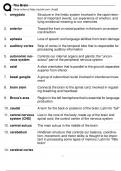Abbie Cromar Unit 19 Assignment 1– Developing Teams in Business 24 September
2015
To: Lynda MacMorrow
From: Abbie Cromar
Date: 24th September 2015
Introduction
A ‘team’ can be defined as a group of people who work together and are
committed to achieving a particular task. There are many types of groups,
and they do not have to be limited to the workplace. For example, you can
have teams within a secondary school such as school council or you could
have a football team.
Types of Teams
There a number of different types of teams. These include formal and
informal teams.
A formal team is one of which that is set up by the organisation to perform
organisational work; this is usually to improve their performance in the
workplace. The main role of a formal team is to help meet the objectives that
are in the organisation’s mission statement. There may be allocated roles
within the group. A formal team may have a written set of rules that they all
follow, and they have far clearer expectations than in an informal group.
There is one type of formal group that has become increasingly popular; this
type of team is known as the ‘Quality Circle’. This is where 8-12 people
within the organisation meet up regularly to consider what they could do to
improve the way that they work. Everyone in this team is prompted to
participate when giving ideas.
Informal teams usually come about when a group of people who share the
same interest of completing a certain goal work together. This type of team
is not ‘officially’ set up by the organisation. Compared to a formal team,
informal teams are quite similar, with regards to the fact that there are no
allocated roles. There isn’t likely to be a written set of rules that members of
this team have to follow, as it is much more relaxed. Once ideas have been
suggested in gatherings that are held, they can then be taken to and
mentioned to managers or supervisors who consider putting the ideas into
action.
Temporary Teams
A temporary team is created for a certain length of time. The members come
together so that they can complete the task, and then part once the job is
completed. When making a temporary team, you must take care when
4
, Abbie Cromar Unit 19 Assignment 1– Developing Teams in Business 24 September
2015
allocating the role of each person so that they are clear on what is expected
of them. You must also make sure that the overall task is clear.
Permanent Teams
A permanent team is one that works together constantly as well as at regular
intervals. For example, a branding team continue to work on the brand, even
after the initial task has been completed. They are always important and the
team never dissolves. Quite often, within the team particular behaviours and
roles are established.
Size of Teams
The size of a team is solely dependent on the task in hand. If a task has to be
completed in a short space of time, then a small team would be quite
sufficient. This is because if you had a large team and they held a discussion,
there would be a lot of things brought up that were unnecessary which would
possibly divert the members of the team away from the task they should be
concentrating on. This would just be a waste of time. It has been said that
the most advantageous team size is five. This is because:
o The group is small enough that each member can have their own role.
o In the event of making a decision (a vote), the odd number will prevent
an equal split.
o The group is large enough that mistakes from attaining insufficient
information can be avoided.
Small Teams vs. Large Teams:
There is a lot of controversy over what size team is the best. A large team is
thought to be a lot more chaotic. The more people there are, the more
communication there is, and it’s most likely that things will be slowed down.
The work completed will be inefficient and therefore goals cannot be met. A
smaller team size means that the chances of social loafing is decreased.
Social loafing is a concept that helps us to understand why as the size of a
team increases, the effort from individuals decreases. Another reason why
smaller teams are better than larger ones is that the larger the team, the
less support an individual may get. This may lead to the member of the team
to feel unimportant, and as a result their overall effort may lack.
Benefits of Teams
There are many benefits to teams. One main benefits of a team is that
productivity is increased. Organisations are always looking for how to
increase productivity or efficiency. Productivity is ‘the relationship between
output and resources. In terms of teamwork this means the amount and
4
2015
To: Lynda MacMorrow
From: Abbie Cromar
Date: 24th September 2015
Introduction
A ‘team’ can be defined as a group of people who work together and are
committed to achieving a particular task. There are many types of groups,
and they do not have to be limited to the workplace. For example, you can
have teams within a secondary school such as school council or you could
have a football team.
Types of Teams
There a number of different types of teams. These include formal and
informal teams.
A formal team is one of which that is set up by the organisation to perform
organisational work; this is usually to improve their performance in the
workplace. The main role of a formal team is to help meet the objectives that
are in the organisation’s mission statement. There may be allocated roles
within the group. A formal team may have a written set of rules that they all
follow, and they have far clearer expectations than in an informal group.
There is one type of formal group that has become increasingly popular; this
type of team is known as the ‘Quality Circle’. This is where 8-12 people
within the organisation meet up regularly to consider what they could do to
improve the way that they work. Everyone in this team is prompted to
participate when giving ideas.
Informal teams usually come about when a group of people who share the
same interest of completing a certain goal work together. This type of team
is not ‘officially’ set up by the organisation. Compared to a formal team,
informal teams are quite similar, with regards to the fact that there are no
allocated roles. There isn’t likely to be a written set of rules that members of
this team have to follow, as it is much more relaxed. Once ideas have been
suggested in gatherings that are held, they can then be taken to and
mentioned to managers or supervisors who consider putting the ideas into
action.
Temporary Teams
A temporary team is created for a certain length of time. The members come
together so that they can complete the task, and then part once the job is
completed. When making a temporary team, you must take care when
4
, Abbie Cromar Unit 19 Assignment 1– Developing Teams in Business 24 September
2015
allocating the role of each person so that they are clear on what is expected
of them. You must also make sure that the overall task is clear.
Permanent Teams
A permanent team is one that works together constantly as well as at regular
intervals. For example, a branding team continue to work on the brand, even
after the initial task has been completed. They are always important and the
team never dissolves. Quite often, within the team particular behaviours and
roles are established.
Size of Teams
The size of a team is solely dependent on the task in hand. If a task has to be
completed in a short space of time, then a small team would be quite
sufficient. This is because if you had a large team and they held a discussion,
there would be a lot of things brought up that were unnecessary which would
possibly divert the members of the team away from the task they should be
concentrating on. This would just be a waste of time. It has been said that
the most advantageous team size is five. This is because:
o The group is small enough that each member can have their own role.
o In the event of making a decision (a vote), the odd number will prevent
an equal split.
o The group is large enough that mistakes from attaining insufficient
information can be avoided.
Small Teams vs. Large Teams:
There is a lot of controversy over what size team is the best. A large team is
thought to be a lot more chaotic. The more people there are, the more
communication there is, and it’s most likely that things will be slowed down.
The work completed will be inefficient and therefore goals cannot be met. A
smaller team size means that the chances of social loafing is decreased.
Social loafing is a concept that helps us to understand why as the size of a
team increases, the effort from individuals decreases. Another reason why
smaller teams are better than larger ones is that the larger the team, the
less support an individual may get. This may lead to the member of the team
to feel unimportant, and as a result their overall effort may lack.
Benefits of Teams
There are many benefits to teams. One main benefits of a team is that
productivity is increased. Organisations are always looking for how to
increase productivity or efficiency. Productivity is ‘the relationship between
output and resources. In terms of teamwork this means the amount and
4



